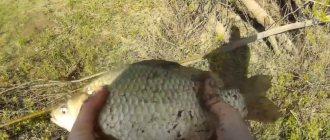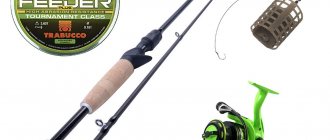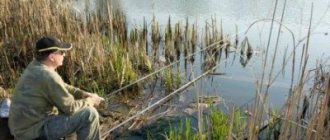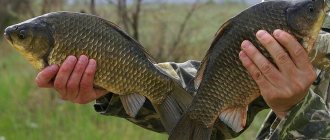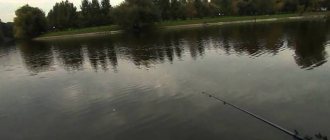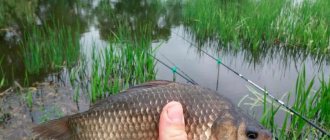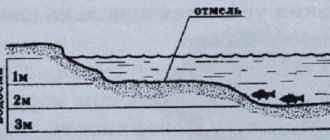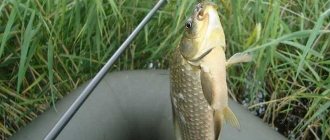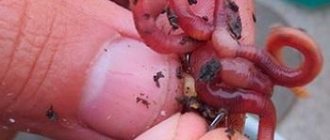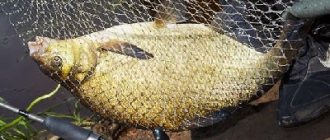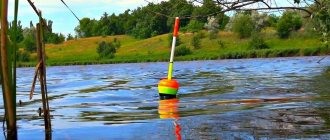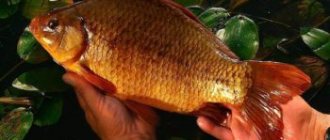Tackle for catching crucian carp in spring
In the spring, crucian carp can be caught in a variety of ways, but fishing with float tackle is considered the most effective. Crucian carp spend a lot of time close to the shore. His favorite places are thickets of reeds and snags. Therefore, it is necessary to stock up on strong tackle, as there is a possibility of snagging thick stems or snags.
The choice of gear depends on the fishing location and the characteristics of the reservoir.
Bolognese telescopic - a distinctive feature is ease of handling. Popular among beginners and experienced fishermen. The presence of a reel and a guide ring allows you to fish from different distances.
.
Telescopic fly fishing rod - there are no rings and a reel, the fishing line is fixed at the end. The casting distance depends on the length of the fishing line along with the rod (from four to seven meters).
Match fishing rod - has guides and a reel seat that allows you to cast over long distances. It is necessary to take into account the distance to the fishing spot. The cast will be further with a longer fishing rod. A length of five meters is usually sufficient.
Plug fishing rod - suitable for experienced fishermen. Requires certain handling skills. The rod is assembled from parts and reaches a length of 16 meters. There are no through parts and no coil. The fishing line along with the equipment is tied to the end of the fishing rod. It lowers into the water silently and with maximum precision in the right place.
.Given the peculiarities of the season, it is best to use:
- Rod - it is better to fish with a fly or match rod, up to five meters long. The best option is light weight poles with a fast action. The ideal ones would be those made of carbon fiber or fiberglass.
- Thread for leaders and main line. First you need to determine how large the fish that are found in the reservoir are. For large crucian carp, a braided or monofilament fishing line with a diameter of 0.2 to 0.3 millimeters is suitable. But the leash needs to be made of fishing line - from 0.1 to 0.4 mm.
- Sinkers with a float . The float is firmly fixed to the fishing line, regardless of the depth of immersion, to avoid snagging on vegetation and to facilitate casting. One or two sinkers are used to immerse the tackle; they should be located side by side.
- Hooks must be selected correctly, since large ones will scare off the crucian carp, and small ones will lead to failure. Hooks, number 14, are suitable for small fish; for large fish, number eight.
Crucian carp slowly awakens after winter and tries to stay as long as possible in dumps and holes that are far from the shore. With the help of a feeder , such areas can be fished. Fishing with a feeder will be effective if the vegetation under water has not yet grown
As air temperatures rise in April, algae begin to grow actively. To make your task easier, you need to go into the water and cut off the reeds, thus artificially extending the period of spring crucian fishing.
Taking into account the possibility of catching several individuals at once, a donka is being made that will be effective for fishing in March and April.
The success of feeder fishing depends on correctly selected bait, which should be flavored with plant and animal components. It is also recommended to use a pacifier (spring equipment). The fish, sucking the mixture, which should be dense, exposes the hook; when it feels it, it tries to spit it out. The nipple is effective due to self-cutting.
Fishing for crucian carp in early spring, selection of gear and video
Today we offer the topic: “fishing for crucian carp in early spring, choice of gear and video” from professional fishermen. We tried to cover the topic as fully as possible. You can ask all questions in the comments after the article.
Most fishermen are looking forward to the arrival of spring. After all, this is the time when active fishing for crucian carp begins. Waking up after winter, this fish tries to get enough and gain strength before spawning. True, despite the increased appetite, catching crucian carp in the spring is not so easy, and only the use of properly selected gear can guarantee a good bite.
One of the most catchy tackles in the spring is a float rod. The fact is that after winter, fish mainly move closer to the shore, where the water is warmer and there is more food in the form of insects, their larvae, plankton, and many others. etc. Therefore, having found a promising place, you can easily catch a dozen crucian carp with a fishing rod and float.
The main thing is not to choose deep-sea areas, but to fish where the distance to the bottom does not exceed 1 m.
Feeder fishing also works well in the spring months. After all, crucian carp (especially large ones) in many reservoirs slowly awakens after winter hibernation, trying at first to stay in holes and dumps, which, as a rule, are far from the shore. The feeder allows you to fish just such areas and, with the proper approach, always come home with a catch. True, the success of feeder fishing in the spring largely depends on properly prepared complementary foods, which must include animal and grain components, as well as strong flavorings.
What other gear can be used in the spring when fishing for crucian carp? Firstly, this is a fishing rod with a side nod. It can be fished in overgrown reservoirs, in coastal snags and reeds. It is best to use a jig as bait. Moreover, larger than for winter fishing. Secondly, they catch it in the spring and with various types of bottom gear. These are “elastic band”, “pacifier”, makushatnik, etc.
However, the most effective tackle for spring fishing for crucian carp is still a regular float rod. It is better to postpone the feeder and donks until summer and autumn. After all, in the spring, crucian carp live as close to the shore as possible, so there is simply no need for long casts. But fishing with a float rod turns out to be much more effective. Just don’t forget to properly prepare this gear – which we’ll talk about next.
For crucian carp fishing in the spring, any plug rod with a length of 5 to 7 m is suitable. However, pay attention to the fishing location. If there are a lot of bushes around the pond that can interfere with casting, then you can use a short rod 4 m long. It is also best to opt for a fly rod. It has no pass rings and does not require a reel. Accordingly, it is easier to equip, and there is much less chance of tangling or snagging the fishing line.
There is an important requirement for equipment for spring fishing - it must be light and inconspicuous. Therefore, the main line is taken with a cross-section of about 0.14 mm. The thickness limit is a diameter of 0.18 mm. There is simply no point in taking a thicker fishing line. Then you shouldn’t get carried away with being too subtle. The limit is 0.12 mm. It’s just that when fishing in spring there is a high chance of getting caught on some branch or snag, so thin fishing line is also not suitable.
It is best to choose an oblong float with a long tip. By weight – no more than 3 grams. It is much better if it weighs no more than one and a half grams. Try to keep the color of the float at the bottom dark, because... you will have to fish at shallow depths, where crucian carp may be frightened by a bright object on the water.
Choose small hooks. If in summer you can successfully catch crucian carp with hooks No. 8 or No. 10, then in early spring he likes smaller bait. For example, bloodworms or small maggots. Therefore, the best option for hooks is No. 12-14. Pay attention to the size of the nozzles. If you are fishing with large worms, then the hook must be appropriate - at least with an extended shank.
Leashes for float tackle should not be made too long. It is enough if they are about 7-8 cm. The fact is that spring crucian carp loves it when the bait lies at the very bottom, without leaving it. If you make the leashes longer, the hook with the nozzle may rise slightly due to the underwater current. Do not forget that it is better to choose a fishing line for mounting leashes that is thinner than the main one.
Lead weights are used to load such gear. Their mass should be no more than half the weight of the float. If, when throwing the equipment into the water, it drifts a little to the side, then you can add a little more sinkers. Do not overload the float rod. In spring, crucian carp is quite cautious, and if it feels resistance when biting, it will simply throw the hook and bait.
In May, the first aquatic vegetation begins to appear in many reservoirs. As a rule, young shoots of algae make their way in areas 15-20 m away from the shore. This is where crucian carp likes to live at this time. In addition, those individuals that by this moment have already finished spawning are also “standing” here. At the end of spring, large fish just preparing to spawn prefer to stay at this distance from the shore.
This is why catching crucian carp with a regular fly rod is not always productive. You have to either use a boat or use a rod with a spinning reel and a sliding float. The latter option is more preferable, because not every fisherman has a swimming device.
Float tackle, designed for long-distance casting, consists of:
- Rods. Preferably telescopic, short in length - about 3.5-4.5 m.
- Reels. It may be the simplest, but certainly inertia-free. The spool size is 2000-3000, so that it can easily withstand a line supply of 50-60 m.
- Fishing lines. The equipment for a long-cast float rod requires a main line with a diameter of 0.15-0.18 mm. Some fishermen also use monofilament with a cross-section of 0.12 mm. But it can be difficult to cast a rig with such a thin line over a decent distance.
- Float. Models with an oblong body and a high top are suitable. The float must be attached to the fishing line using a carabiner with a clasp. So, you can quickly change it to another. The weight of the float depends on the fishing location, but best of all – no more than 3-5 grams.
- Loaded. There are a lot of options for how you can load a fishing rod with a sliding float. The number and weight of sinkers depends on the presence of current, wind, etc. The main thing is that they are distributed along the equipment: near the leash, just below the float and at a distance of 50-100 cm from the sub-fishing.
- Kryuchkov. According to international numbering – No. 8-12. Focus on the size of the crucian carp you will catch. The larger it is, the larger the hook should be.
There are several ways to mount a fishing rod with a float, which will be used for long casts. Let's consider two mounting options that are perfect for spring crucian fishing.
You will need high-quality monofilament fishing line with a cross-section of approximately 0.2 mm. An upper movable stopper is placed on it, which will adjust the depth. Next, place a float weighing 3-5 grams. Below is the main load in the form of a stopper and two sinkers (one large, the other slightly smaller), which should be at a distance of 100-120 cm from the hook.
A swivel is attached to the end of the main line, from which comes a leash about 25 cm long. It is advisable to install an additional weight. For example, on the main line we step back 20-30 cm from the swivel and attach 3 lead pellets weighing 0.15-0.25 g. each. A little higher at about the same distance - 3 more of the same weights. It turns out that the entire load is evenly distributed throughout the entire equipment, increasing the sensitivity of the equipment.
Another installation of float tackle for long-distance casting is distinguished by the fact that the main load is located approximately in the middle. That is, it is separated from the leash and the float by a distance of 60-90 cm. The main load is a sinker in the shape of a so-called “olive” (weighing 1-2 grams), which is fixed on both sides with small pellets (0.15-0. 25 gr.). In addition, it is necessary to install a sub-sink - a small sinker next to the swivel from which the leash comes.
Fishing for crucian carp in spring bait
After a long winter, the crucian carp runs out of energy reserves, which are necessary for the upcoming spawning. Therefore, any attachment will work well, even if there is no particularly nutritious complementary food. But for fishing to be successful, it is recommended to use pearl barley, millet, wheat and other cereals as complementary foods. Flavorings play an important role - vanilla, ground seeds, dill, etc. If the fishing location is chosen well and the complementary food is chosen correctly, you can do without flavorings.
You can use protein dough. It has a variety of flavors and high protein content.
Protein dough can be prepared at home. To do this, take corn flour (100 grams), soy flour (200 grams), semolina (50 grams), milk protein (400 grams). All components are mixed, salt and six raw chicken eggs are added. The dough should be elastic.
Catching crucian carp in spring with a float rod
In spring, all the fish in the reservoir prepare for spawning. For this reason, fishing is allowed only with fishing rods, of which the float rod is the most suitable and effective. The success of fishing depends on how well the preparation is carried out and the behavioral characteristics of the crucian carp are studied.
One of the options for a float fishing rod is that the float is fixed and does not move. The length of the rod itself should be about four meters and depends on the casting distance. The second option is a reel with a sliding float that slides along the fishing line. The depth is adjusted by a rubber stop fixed above the float. Using a reel, the hook is cast to the selected distance.
Fishing tackle should be light so that you can notice even the smallest bite. This ensures that the crucian carp does not feel the tackle. It is also desirable that the color matches the color of the water in the reservoir and the color of the bottom. A coarse fishing line is not suitable, as it can scare away the fish after the first bite. The recommended line diameter is 0.2 mm. There should be no roughness or thickening on the line.
It is recommended to change the line on the fishing rod every year, since its strength weakens during use.
The selection of fishing line must be taken responsibly; it is noticeable in the water and scares away the fish. A thin monofilament line that matches the color of the water and bottom, with a diameter of 0.16 mm, is quite suitable. Crucian carp is a cautious fish, so the equipment must be sensitive. The length of the leash depends on the characteristics of the bite (average 15 centimeters). If the bite is active, you need to make the leash shorter. For sluggish and cautious biting, you need to choose a thin and long leash.
To quickly replace the leash, you need to stock up on a set of different lengths.
Hooks play an important role; they have different lengths and thicknesses. Small hooks hook fish with difficulty; fish may not take large hooks. Fragile ones can break, and soft ones can bend. To choose the right hooks, you need to know the expected size of your prey. The hook consists of a fore-end, a sting with a barb and a hook. The shape of the head can be in the form of a ring (suitable for beginner fishermen) or a spatula. Experienced fishermen like to catch crucian carp on a hook with a bend width that is shorter than the shank length. Suitable hooks are numbers 5 and 6, for large fish - 7.
A tenacious beard and a sharp sting are the main requirements for a hook.
The choice of float depends on the fishing conditions. If fishing takes place in a boat, a float weighing two grams, light and fixed is recommended. If the reservoir is overgrown with reeds, long casts are not needed, since the fish love just such places.
Slapping the water will scare away the fish. For fishing from the shore, in a reservoir with great depth, floats weighing eight grams are used. For visibility from a long distance, it is better to use a float with a bright color and adjustable weight. On rivers with fast currents, floats weighing seven grams are used, with fixation.
Catching crucian carp in the reeds in spring
Reeds, like other vegetation, are a favorite habitat for crucian carp. Here it hides from predators, eats small larvae, crustaceans and young shoots of plants. In such places, crucian carp spend most of their lives and spawn. Thus, fishing in the reeds is the most successful and allows you to always remain with your prey. Among the reeds they choose a so-called “window” or a strip along the shore. As for the depth, it can be from 15 centimeters to two meters. If there is no such window, you need to clear it yourself. You can fish both from a boat and from the shore. When fishing from a boat, it is necessary to clear a kind of path so that the tackle does not cling to the reeds.
Fishing for crucian carp from ice in spring
Fishing on the last ice in the spring is always unpredictable. It depends not only on the experience of the fisherman, but also on many other factors. For example, it depends on how well-fed the crucian carp lay down for the winter, what the temperature was in the winter, whether there were thaws, and what the nature of the coming spring was.
The best weather conditions throughout the year are cold summers, warm autumns and winter days with thaws. Crucian carp gain a lot of fat under such weather conditions. With the first rays of sunshine, crucian carp begins to look for food, therefore, the freeze-up period is the best time. When choosing a reservoir, pay attention to the appearance of cracks. On small reservoirs there are almost no such problems. It is better to plan in advance to prepare for catching crucian carp from the ice in the spring. In the fall, examine small ponds or rivers along the main channel. Places must be snarled.
Gas cuttings are places where you can see a lot of bubbles through the ice. The crucian carp will not live here, as methane can poison it. The edge of the dead zone, where there is grass and snags, is the best place.
Activity in early spring, the crucian carp has not yet reached and does not spread across the reservoir. Usually concentrated in one or two places. You need to start fishing at 12 noon, and in sunny weather, a couple of hours earlier. The bite stops towards evening, and when dusk comes, nothing can be caught.
Crucian carp bite well in warm sunny weather, but are not interested in bait on cold days and cloudy weather.
When the ice begins to melt, the crucian carp does not go deep (no more than two meters to a depth). Therefore, it is better to look for it near the coast. The most unsuitable reservoirs for catching crucian carp in the spring from ice are those where crucian carp are mainly bred. In such reservoirs there is no current, the fish are sluggish and inactive, and it is impossible to lure them with bait. An ideal place would be a pond where there is running water and other species of fish live, but the population of crucian carp should prevail. In such a pond, fish move to the upper reaches, where more oxygen enters. The presence of snags creates favorable conditions for crucian carp, where they can hide and feed. During the period of active ice melting, crucian carp moves to flat areas, away from the channel, as cold water coming from the channel drives the fish away. It often happens that crucian carp are found in places where there is no current. Crucian carp does not like warm water, but is attracted to the presence of oxygen.
In the spring, it provides a good bite in a flowing pond, reducing the water level. Cold water enters the reservoir in large quantities and the crucian carp begins to look for warm places, which are characterized by the presence of food.
When going fishing on spring ice, it is necessary to take safety precautions into account. It is necessary to leave the ice in the following cases:
- characteristic hissing of ice and sagging;
- water splashes out of the holes;
- when drilling, water pours out (the ice is saturated with water and can collapse at any moment);
- the drill falls into the ice easily;
- the fishing line clings to the edge of the ice (bottom), the ice softens from the weight of the jig.
Gear and equipment. What to use to catch crucian carp?
The fish does not respond to bait during this period. Among the baits it prefers are small worms, bloodworms, and maggots.
On the rivers during this period, crucian carp are also caught using mastyrka and protein dough.
In places where the ice cover is still strong, crucian carp are caught using:
Winter float gear;
Mormyshka (including nozzleless ones).
Of the gear used during the open water season during this period, the best are considered:
Flying equipment;
Plug accessories;
Short Bolognese tackle.
Equipment requirements:
Main line - up to 0.18 mm;
The float is light - up to 1.5 g;
A small cross-section leash (if possible, made from the thinnest, most transparent fishing line or fluorocarbon) - up to 0.12 mm;
The hook is selected based on the type, color and size of the bait used.
Catching crucian carp in the spring with a side nod from the shore (video)
The water in the reservoir warms up to 10 degrees Celsius. The sprouts of the first aquatic plants appear. This period begins towards the end of April and continues on some reservoirs until the end of May. Officially it is called pre-spawning.
The crucian carp finally comes to its senses after hibernation and begins to actively prepare for spawning. During this period, the crucian carp actively and intensively feeds.
Most often, this fish can still be found in shallow areas of the reservoir, but only because the first aquatic vegetation appears there and more food can be found.
The basis of nutrition for crucian carp during this period is food of animal origin. The only peculiarity is the size of the bait. It is better to use small baits.
The crucian carp already reacts to bait, but in spring fishing the principle “do not overfeed” applies. The fish does not eat much during this period; there is a risk of saturating it by placing too much bait on the bottom.
Fishing for crucian carp in the spring can be successful throughout the entire reservoir, using both float gear and bottom equipment.
In addition to the gear that was mentioned in the previous paragraph, you can add:
Match tackle;
Feeder and picker equipment.
Classic donka and donka using feeders, but do not forget about the spring fishing ban, which limits the number of hooks used in the tackle.
Gear requirements:
Main line - up to 0.22 mm;
Float - up to 3 g;
Thin leash (if possible made of fluorocarbon) - up to 0.14 mm;
The hook is selected based on the type, color and size of the bait used.
This period ends with the spawning of fish. The water temperature exceeds 15 degrees Celsius. Lush flourishing of aquatic vegetation.
Catching crucian carp in the spring on a feeder (video)
Catching crucian carp in spring with a jig
Fishing with a jig in the spring is the most profitable and effective. Only large individuals react to it. The advantage of jig fishing is the use of small baits. You need to choose a jig, paying attention to the color. Light and shiny, it will scare away crucian carp, but a shaded one, on the contrary, will attract it. It is recommended to choose an elongated jig from five to six millimeters, length, together with the hook, from one millimeter to 1.2; width - from two to three mm.
Black tungsten pellets are supplied with an additional weight. It is not recommended to skimp on leashes to avoid breakages.
To attach the hook, use maggots, bloodworms or worms. For jig fishing to be successful, silence must be maintained. Having felt any noise, the crucian carp swims away, so it is important to even approach the fishing spot carefully. The next condition for good fishing is playing with a jig. First, it is lowered to the bottom, where, quite possibly, the crucian carp can swallow the bait. If this does not work, you need to gradually begin lifting the jig (one centimeter per second), while pausing after seven centimeters.
During the pause, you can make jerks, but do not get carried away. The crucian carp will not respond to horizontal wiring.
The main types of bait for crucian carp in spring
At the beginning of spring, crucian carp are hungry, but selective and do not pay attention to all baits. Mood is significantly affected by weather conditions and temperature. In cold weather, bloodworms, maggots, and worms are used. After warming up, you can start using vegetable baits: semolina, pea porridge, dough, pearl barley.
Article on the topic: Mini boilies for crucian carp
Catching crucian carp in the spring with a nod
Fishing for crucian carp with a nod fishing rod in the spring has become very popular among amateur fishermen. Usually fishing occurs from a boat, with a carbon fiber rod, four to five meters long. When fishing from the shore or from the water, you need to take a longer fishing rod - up to eight meters. The equipment, in this case, must be running with a reel seat and a through end. Monofilament (from 0.16 to 0.18 millimeters) is wound on an inertia-free reel. The nod is made of synthetic flexible material.
The nod should be long enough and sensitive to a weak bite. The tip of the nod is painted in bright colors so that it is clearly visible. For bait, bloodworms, maggots and dung worms are used. Nozzles made from plant materials are not used on the nod. Jigs must match the color of aquatic organisms; shot, ant and drop have proven themselves well. To catch large specimens, large jigs with several hooks are also used.
Suitable places for fishing with a nod are snags and with vegetation (reed with algae). The water should be clean with “windows” up to one and a half meters deep. The main condition is that the sun's rays do not fall into the windows, since the bright light scares off crucian carp. Slowing down the jig when lowering is tempting for crucian carp. Another way is to lift the jig from the bottom in a slow rhythm, shaking it slightly. Crucian carp picks up a jig lying on the bottom in a cloud of turbidity, or when it rises from the bottom.
If this method does not give results, the jig needs to be lifted from the bottom ten centimeters and rocked. This technique has proven itself well in areas with drowned bushes and well-grown vegetation. Fishing with a nod differs from fishing with a float rod, since the nod often and intensely strikes the bows and is felt by the hand holding the rod.
Fishing - crucian carp, hooked on a jig, is carefully brought to the surface of the water. After the crucian carp appears on the surface, it is carefully brought to the boat, preventing its head from falling into the water. The crucian carp is taken out of the water with a landing net, otherwise the fishing line may break. Particular attention should be paid to landing large fish, as they offer resistance. It is important not to let the crucian carp go into snags and vegetation.
Adviсe:
- To make the jig visible to the crucian carp, attach beads, maggots or foam rubber.
- When fishing with a nod, various feedings are successfully used, the main thing is not to overdo it.
- It is important to change jigs as often as possible, as the crucian carp gets used to the bait and swims past.
Crucian carp fishing in spring places
The most successful place for catching crucian carp in the spring will be a pond where there are no strong currents and have shallow depth. Here the water warms up quickly and is most suitable for early spring fishing. Crucian carp moves around the reservoir in search of food after a long winter hibernation. You can find habitats in a pond by the bubbles that form when crucian carp look for food in the mud. The depth in such places is usually no more than half a meter.
Tips for choosing a location:
- The peaks of the edges are located near the shore.
- Small areas along the coast with vegetation that is flooded during high water.
- Thickets, one to one and a half meters deep, of reeds and algae.
- The places are snarled; here the crucian carp finds shelter from predators.
When does crucian carp start biting in the spring?
Crucian carp is a dark fish, has no education, is not trained to use a calendar, so the onset of spring for him is not the first of March, crucian spring means the water warming up to a temperature of about 5 degrees. Then he wakes up completely and irrevocably and begins to actively feed. It is then that fishing for crucian carp in the spring will be very productive. However, crucian carp can be caught from the last ice in March, you just need to use the right gear and approach the process wisely. For successful fishing for crucian carp from the ice in spring, the weather is also important - choose a clear day. Remember about your safety, the last ice is treacherous, so follow the safety rules, do not crowd together, do not stomp, and do not test the strength of the ice by jumping.
Winter fishing rod (balalaika) (Winter 1) Tonar 74 for 1 piece. Winter fishing rod Pier 50-Pl PIRS 61 for 1 piece. Axleless winter fishing rod Balalaika PIRS 140 for 1 piece. Winter fishing rod. STFS green (STFS-G) Helios 193 for 1 piece. Winter fishing rod Pier 55-C PIRS 79 for 1 piece. Winter fishing rod WH 56P L200 Pier Master 150 for 1 piece. Winter fishing rod with shortened medium polystyrene handle (Winter 1) Tonar 84 for 1 pc. Fishing rod Perch WHP 56P L200, ChZ Pier Master 95 for 1 piece.
Choose a winter fishing rod for crucian carp fishing
